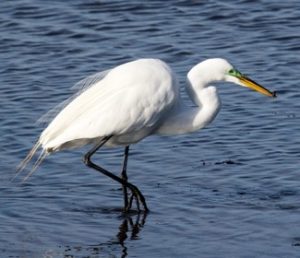The western shores of Barnegat Bay directly border the region of New Jersey known as the Pine Barrens or Pinelands. Situated on the sandy, acid soils of New Jersey’s outer coastal plain, the Pine Barrens comprise a landscape of upland pine-oak forests interlaced with a network of “tea-water” streams, dense swamps and ericaceous bogs. The Pine Barrens supports more than 500 species of animals and 800 species and varieties of plants (McCormick and Forman, 1979; Buchholz and Good, 1982; Good and Good, 1984).
By no means an undisturbed wilderness area, the Pine Barrens were heavily impacted by bog iron mining, glass blowing, timber harvesting and charcoal-making industries during the 1700’s and 1800’s. Subsequent to this early industrial period, human disturbance has been comparatively light allowing the re-growth of the extensive forests that give the Pine Barrens its name. Occupying a contiguous area of approximately 450,000 ha, this lightly-settled region represents one of the largest tracts of comparatively “natural” landscape remaining on the US eastern seaboard. To protect the Pine Barrens from inappropriate development, legislation was passed in 1978 to create the New Jersey Pinelands National Reserve (NJPNR) (Collins, 1988).
The Pine Barrens landscape is characterized by a complex mosaic of ecological land types: discrete patches or, more often, corridors of cedar and hardwood swamps amidst a background matrix of upland pine and oak forests (Forman, 1979). The upland forests are better characterized by a continuous gradient with pure pitch pine (Pinus rigida) stands on one end grading into pure oak (Quercus spp.) at the opposite (McCormick, 1979). Due to the relatively open canopy of the upland forests, the generally well-developed understories are dominated by either scrub oak (Quercus ilicifolia) or various heath plants such as mountain laurel (Kalmia latifolia), huckleberry (Gaylussacia spp.), and blueberries (Vaccinium spp.). These upland forests, in turn, grade into pitch pine lowland forests depending on the hydrological regime.
Over the past two hundred years, humans have had a tremendous influence on determining the characteristics of the region’s vegetation communities (McCormick, 1979; Zampella and Lathrop, 1997). The pitch pine (Pinus rigida) dominated forests of southern New Jersey are a fire-dependent vegetation community. The intensity and frequency of fire are among the most important factors determining the structure and composition of Pinelands forest communities (Little, 1979; Forman and Boerner, 1981). Subsequent to fire, pitch pine has the ability to resprout from the basal root crown and along the trunk and limbs (Harshberger, 1916). Oaks also exhibit basal sprouts. Pitch pine also displays the ability to produce serotinous cones which protect the pine seed from the high temperatures of the fire. Subsequent to the fire, the cones then release the seed, permitting pitch pine to rapidly colonize newly available sites suitable for seedlings.
Areas of high-fire frequency have been shown to have greater local incidence of serotiny (Givnish, 1981). Under the highest fire frequencies, the upland forest vegetation assumes more of a dwarfed scrubby woodland locally known as pygmy pine plains (McCormick and Buell, 1968; Buchholz and Zampella, 1987). The East Pine Plain, home to a number of unusual prostrate shrubs such as bearberry (Arctospaphylos uva-ursi), pyxie moss (Pyxidanthera barbulata) and the endangered broom crowberry (Corema conradii) (Harshberger, 1916), is on the extreme western border of the Barnegat Bay watershed. It is suggested that changes in fire regime related to more effective fire control may result in changes in landscape patterns, including a gradual transition from pine to oak-dominated forests (Little, 1979; Forman and Boerner, 1981).
The composition of Pinelands wetland plant communities has been extensively studied and described (Roman and Good, 1983; Tiner, 1985; Zampella 1991). Following McCormick’s (1979) widely used classification of community types, Pinelands wetlands include Atlantic white cedar (Chamaecyparis thyoides) swamp forests (Little, 1950, 1951; Olsson, 1979; Roman et al., 1990; Ehrenfeld and Schneider, 1991; Zampella and Lathrop, 1997), broadleaf or hardwood swamp forests dominated by red maple (Acer rubrum), and black gum (Nyssa sylvatica) (Olsson, 1979; Bernard, 1963; Ehrenfeld and Gulick, 1981), pitch pine lowland and pine transition forests (Olsson, 1979; Roman et al., 1985; Zampella et al., 1992), shrubby wetland communities (Olsson, 1979), and herbaceous wetland communities, including both submerged and aquatic vegetation (Olsson, 1979; Morgan and Philipp, 1986). Atlantic white cedar swamps are presently receiving consideration for additional conservation and restoration efforts due to years of indiscriminate logging and past modifications associated with residential development and cranberry bog agriculture.
The unique character of Pinelands flora is widely recognized (Christensen, 1988). Pinelands wetlands support a large portion of the region’s floral biodiversity, including many rare plant species (Fairbrothers, 1979; Snyder and Vivian, 1981; Roman and Good, 1983). Although forested wetlands are dominated by a few tree species, including red maple, Atlantic white cedar, black gum, pitch pine and sweetbay (Magnolia virginica), more than 20 shrub species are found in the understory. Blueberries (Vaccinium spp.), swamp azalea (Rhododendron viscosum), sweet pepperbush (Clethra alnifolia), and greenbrier (Smilax spp.) are generally dominant.
Where these forested wetlands merge into the Barnegat Bay coastal region, American Holly (Ilex opaca) often becomes an important component of the sub-canopy. Biologically significant species occurring in wetlands include endemics such as New Jersey rush (Juncus caesariensis) and sand myrtle (Leiophyllum buxifolium), peripheral and disjunct southern species such as turkeybeard (Xerophyllum asphodeloides) and false asphodel (Tofieldia racemosa), and curly grass fern (Schizaea pusilla), a northern peripheral species (Fairbrothers, 1979). The federally endangered swamp-pink (Helonias bullata) and Knieskern’s beakrush (Rhynchospora knieskernii) are also found in Pinelands wetlands.
This is an excerpt from Chapter 6 of the “Scientific Characterization of the Barnegat Bay-Little Egg Harbor Estuary and Watershed” (September 2001).

